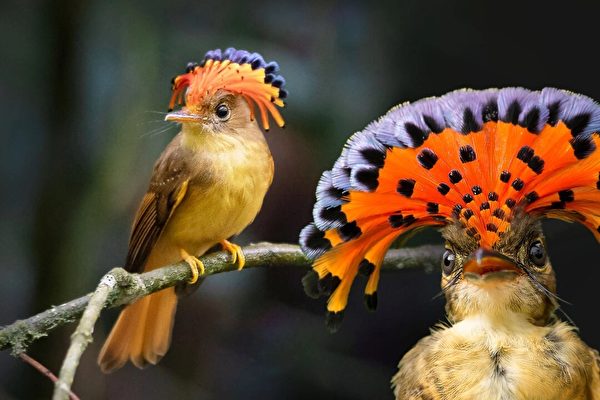The intricate red badge waving in the air catches people’s attention, a crimson tassel hanging on the jungle vines, this is the feather crest of a small bird. The royal flycatcher swings its signal, perfectly showcasing its presence. But why does it do this?
A second crown appears near the first, with a different hue of pale yellow, but swaying just as delicately. This is the female royal flycatcher, the first red crest is the male, her mate. The “vines” dangling with leaf fragments are their very unique and understated jungle nest.
The colorful crests of the two birds look like large fans on top of their heads, able to be completely hidden when retracted into the head, but can be raised high when signaling is needed.
It seems that something romantic might soon unfold in the nest, as we know that one of the main reasons the royal flycatchers display their crests to each other is for mating, although there are other circumstances as well.
In addition to mating rituals, male royal flycatchers may display their crests to chase away invading males. Conversely, females in the nest may show their crowns to ward off competing females.
When held in human hands (yes, they can be held), these birds are also known for performing for us. Displaying their crest feathers in the hands of humans, their heads gaze hypnotically at us, beaks agape. Truly a spectacle!
People know very little about royal flycatchers. Their pendulum-shaped nests are made of various plant fibers, often hung on thin branches or vines over riverbeds, making it difficult for predators to reach. These birds are common in the forests of South America, from Brazil to Peru, as well as in southeastern Mexico and Central America.
Weaving these highly concealed nests is the task of the females. Females typically lay two unusual reddish-brown eggs after mating, with some dark spots. Males do not always have just one mate, sometimes they may have two.
In the nest, one can occasionally hear the females vocalize, emitting a two-syllable call that sounds like “keeyup.” While the males produce a series of descending mournful whistles, followed by a shorter note that sounds like “whi-peeu, peeu, peeu…”
Their bright feathers of the crests are usually tucked back, while the rest of the feathers are drab olive-brown, except for the pale yellow rump and reddish-brown tail. They have unusually short legs, long flat bills used to catch beetles, flies, grasshoppers, and other small insects on wings, like skilled aerial acrobats.
The royal flycatcher is far from being endangered, they are numerous in number, but still difficult to study in their natural habitat. Because crest displays are not frequent, their crest signals are also elusive. But whether intentional or unintentional, as the royal flycatcher sits in human hands, waving in a wavelike display, there is no doubt: it greatly captures our attention.

